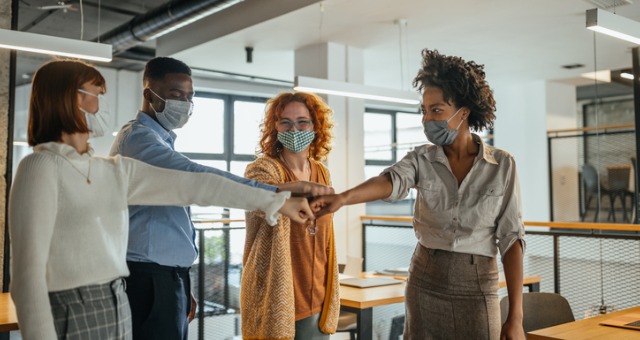In November 2019, I was fortunate to take about 20 of our physics students to the Physics Congress (PhysCon) in Providence, Rhode Island. The conference was a hoot, and I have many fond memories including a late-night conversation in the hotel lobby with several of my students. They eagerly told me everything they learned throughout the day. Their ideas came out so fast, it was difficult to make sense of it all. Career paths were being changed on the spot and you could feel the excitement in the air.
Fall 2019—doesn’t that seem like a hundred years ago?
Being together as a community was the whole idea for us back then: work in a small academic department where you know everyone, conduct research in a lab throughout your first year, and attend some amazing academic events where you can talk with your departmental chair about career options. This is what I signed on for when I decided to work at an institution that is primarily undergraduate, and it’s the reason many of my students are at Adelphi University. It creates a real opportunity for them to grow into their careers and not get lost in giant lecture halls with hundreds of students. The one-word students use to describe our department: community.
Then COVID-19 happened. Some of our in-person activities were canceled completely and others were shifted online. The online club meetings, virtual conferences, and online award celebrations were good, but they lacked the genuine “ah-ha moments” of chatting with your peers and mentors; they lacked the moments before and after meetings when folks checked in with one another and shared a laugh. In short, they lacked togetherness.
A recent article in the Chronicle of Higher Education, Seven Practices for Building Community and Student Belonging Virtually, gave us insight into how we might solve some of these issues in a virtual environment. Small departments everywhere have tried to adapt as quickly as possible to the COVID crisis; however, some are at a disadvantage as most of the infrastructure is designed around fostering community with an in-person environment, not a virtual one. Many colleges and universities are under financial strain and looking for places to cut, and small academic departments are under stress. Pre-COVID, these small- to medium-sized departments sold “togetherness” to their would-be majors. But these small departments suddenly—and I hope temporarily—lost their main selling point of community and togetherness.
Togetherness is still a wonderful goal for many academic departments, and students can benefit greatly by focusing on it—we just have to work around COVID.
Here are a few suggestions for increasing departmental togetherness in these difficult times:
Plan picnics for your students and colleagues. These can be held outside safely. Don’t get too complicated. Host the event, get some food, put out a couple of frisbees and then stand back and let your guests have fun. I am also particularly fond of campfires.
Find professional reasons to have outdoor events. (Tonight, we are doing our astronomy night and will get a good look at Venus, Jupiter, and Saturn.)
Something I have learned from a former mentor—take your lunch period and get food with your students. Have a rule that if it isn’t raining, you will be eating lunch in the quad and students are welcome to join.
Give students plenty of opportunities to work together by holding group study sessions, assigning group projects, and even encouraging students to work together for portions of exams. Keep mixing up the groups so students get to know everyone in the class.
Get students to share hidden talents and interests, and make sure to celebrate when you find out one of your students is, say, a brilliant opera singer. One assignment I use is asking students to teach a class and be creative about it. I have them showcase their singing/rap, dancing, or artwork by turning it into physics lessons that they are proud of.
Bringing pizza to an event is commonly known as the gold standard for getting students to attend your events. Though, the idea of college students fighting over a slice of pizza in the age of COVID is a little scary; however, these kinds of events are still possible—you just have to get creative. Recently, I purchased sandwiches for a departmental picnic. I asked the deli to individually wrap each sandwich. In fact, all the food we bought for the event was individually packaged, and since the event was outside, attendees felt comfortable eating.
One of the things that I struggled with this fall semester was staying patient and flexible. Whenever we planned an event, there was always a risk that the event would be canceled or postponed for reasons outside of our control. Midway through the semester I got a normal cold, and as part of the university’s protocol, I had to stay off campus even after I started feeling better. Because of this, I had to postpone a number of events. It was tricky to stay positive, but I found that everyone was patient and very flexible with all of the sudden changes. In the end, I felt it was better to at least try and handle the setbacks than to not try at all.
The process is slower than normal. Events we would have done in the past without extra thought now require multiple bureaucratic hurdles, but we need to start coming back together and connecting. Students and faculty are eager for togetherness—COVID makes that more difficult—but it is something we need now more than ever.

